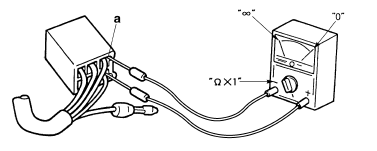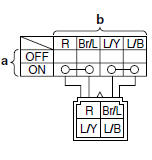Yamaha YZF-R125 Service Manual: Checking the switches

1. Clutch switch
2. Main switch
3. Front brake light switch
4. Sidestand switch
5. Rear brake light switch
6. Neutral switch
7. Turn signal switch
8. Horn switch
9. Dimmer switch
10.Pass switch
11.Engine stop switch
12.Start switch
Check each switch for continuity with the pocket tester. If the continuity reading is incorrect, check the wiring connections and, if necessary, replace the switch.
| CAUTION: Never insert the tester probes into the
coupler terminal slots "a". Always insert the probes from
the opposite end of the coupler, taking care not to loosen or damage the
leads. |
NOTE:
- Before checking for continuity, set the pocket tester to "0" and to the " × 1" range.
- When checking for continuity, switch back and forth between the switch positions a few times.

The switches and their terminal connections are illustrated as in the following example of the main switch.
The switch positions "a" are shown in the far left column and the switch lead colors "b" are shown in the top row.
The continuity (i. e., a closed circuit) between switch terminals at a given
switch position is indicated by
"  ". There is continuity between
". There is continuity between
red and brown/blue, and blue/yellow and blue/black when the
switch is set to "ON".
 Electrical components
Electrical components
1. Main switch
2. Clutch switch
3. Front brake light switch
4. Ignition coil
5. Throttle body sensor assembly (intake air
pressure sensor, intake air temperature
sensor, throttle position se ...
 Checking the bulbs and bulb sockets
Checking the bulbs and bulb sockets
NOTE:
Do not check any of the lights that use LEDs.
Check each bulb and bulb socket for damage or
wear, proper connections, and also for continuity
between the terminals.
Damage/wear Repa ...
Other materials:
Checking the tires
The following procedure applies to both of the
tires.
1. Check:
Tire pressure
Out of specification Regulate.
WARNING
The tire pressure should only be checked
and regulated when the tire temperature
equals the ambient air temperature.
The tire pressure must be adjuste ...
Checking the front brake disc
1. Remove:
Front wheel
Refer to "FRONT WHEEL" on page 4-6.
2. Check:
Brake disc
Damage/galling Replace.
3. Measure:
Brake disc deflection
Out of specification Correct the
brake disc
deflection or replace the brake disc.
a. Place the vehicle on a suitable stand ...
Installing the front fork legs
The following procedure applies to both of the
front fork legs.
1. Install:
Front fork leg
Temporarily tighten the upper and lower
bracket pinch bolts.
NOTE:
Make sure the inner tube end position "a" is 24.5
mm (0.96 in) from the top of the upper bracket.
2. Tighten:
Lower br ...

